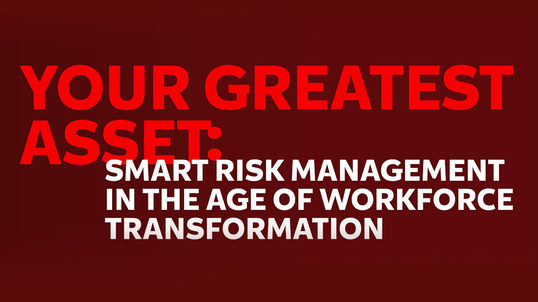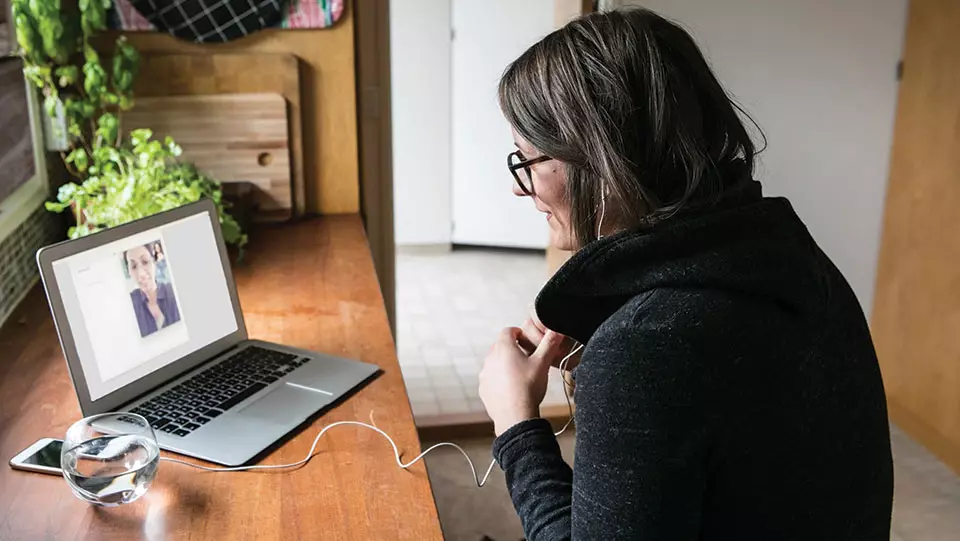Your Greatest Asset: Smart Risk Management in the Age of Workforce Transformation

Chapter #1 | Chapter #2 | Chapter #3 | Chapter #4 | Chapter #5 | Full Webinar Video
Whether you call it the Great Resignation or the Great Reshuffle, this post-pandemic phenomenon has driven unprecedented organizational change in a short amount of time. Risk managers have always played a critical role in keeping both new and tenured employees safe, and now it is more important than ever for risk managers to use their analytical skills to uncover important employee injury trends and clearly communicate these findings to senior leadership.
Hear from Elizabeth Carter, Director, Forensics and Resilience at BDO’s San Francisco Office; Rich Ives, VP, Workers Compensation at Travelers, and Danielle Sobocinski, RMIS Senior Information Account Consultant at Travelers, to learn more about how successful companies focus as much on employees as they do on customers and how risk manager can use data to understand and address the long-term impacts of workers compensation claim trends.
(DESCRIPTION)
Travelers logo. Text, Impact of the Pandemic on Workplace Injuries
Slide, Impacts of the Pandemic. On the left-hand side of the slide is an image of three people wearing yellow safety vests, hard hats, and face masks inside a warehouse. On this image is a red arrow pointing up, next to the text, Increase in People Starting New Jobs. On the right-hand side of the slide, there is an image of a van, a truck, and a car moving down a highway. On this image is a red arrow pointing down, next to the text, Decrease in Frequency, and a red arrow pointing up, next to the text, Increase in Severity.
(SPEECH)
RICH IVES: Increasing resignations, retirements-- really, if you think about it, a shuffling a lot of jobs and employees-- is happening currently right now. And so it not only presents a risk currently right now, but think of it this way. Even if the current rate of movement dropped to historical levels, the risk of how many new employees are new in their role is going to be with us for the next year or so. So regardless of what happens in the economy going forward over the next six-twelve months, this risk that we're highlighting currently right now is a key one to pay attention to.
Now, second, in some instances, severity of claims has gone up. During the pandemic, there were fewer vehicles on the road, which we thought would result in less accidents. And we did see a drop in the number of motor vehicle accidents, particularly in workers compensation. But the severity of those claims actually went up as people were driving at a much faster rate of speed, given less congested roads.
(DESCRIPTION)
Travelers logo on white background.
Chapter #2
Case Examples: Failures and Successes
“Once we were able to understand the pain point of the pandemic for this particular customer, it allowed us to focus on other areas of opportunity that might be controllable to help them – really, eliminating the noise and hopefully being able to focus on more controllable opportunities."
Danielle Sobocinski, RMIS Senior Information Account Consultant at Travelers
(DESCRIPTION)
Travelers logo. Text, Impact of the Pandemic on Workplace Injuries
Slide, Case Example, A Manufacturer with Pockets of Incidents. On the right-hand side is an image of a man wearing a hard hat and safety glasses looking down at machinery. Text, Risk Manager Tip, The macro analysis does not always show the full picture. There are benefits to drilling the data down to reflect things like geography and divisions.
(SPEECH)
DANI SOBOCINSKI: With the impacts of the pandemic on the auto parts business, this company unfortunately had to furlough many employees. Although company-wide, when we were actually analyzing the data, we had seen a decrease in their frequency rates, there were actually some select plants that we noticed with significant increases. And as you mentioned earlier, of course, Cora, unfortunately, due to the auto parts shortages, the customer actually explained that they had select plants working stressful production schedules just to meet the demands of their particular customers.
So once we were able to understand the pain point of the pandemic for this particular customer, it allowed us to focus on other areas of opportunity that might be controllable to help them-- really, eliminating the noise and hopefully being able to focus on more controllable opportunities.
(DESCRIPTION)
Slide, Case Example, A Warehouse Full of Positive Momentum. On the left-hand side of the slide is an image of stocked warehouse shelves with a table topped with a hard hat and computer screens displaying information. Text, Risk Management Tip, Its important to continue to execute protocols that are resulting in positive outcomes even during times of disruption.
(SPEECH)
DANI SOBOCINSKI: And the last example I'll share is with one of my retail customers. I think that their story is a great example that you can have some positive outcomes in such a challenging environment. A few months ago, when I was analyzing their data, I had noticed a significant reduction in frequency and severity for the past few years. Which I really thought was odd, since they were an essential business during the pandemic. Historically, this company had battled really high attorney involvement rates in their warehouse specifically, which really was driving severity for them.
So what they did was, just before the pandemic, the customer actually set some goals, they focused on early reporting and their post-injury management practices, to ensure that employees was a top priority. They really wanted to focus on engaging their employees in any way possible within their claim. So really impressive-- as an essential business during the pandemic, they actually were able to maintain results-- decrease even-- this account continued to execute their protocols, which really helped decrease attorney involvement in an extremely litigious area and decrease the overall severity of their claims.
(DESCRIPTION)
Travelers logo on white background.
(DESCRIPTION)
Travelers logo. Text, Impact of the Pandemic on Workplace Injuries
Video of a woman with the text, Elizabeth Carter. Slide, Shifts in Workplace Culture. On the lefthand side of the slide is a photo taken from a darkened hallway in through a doorway of a man sitting in an office, working at a desk. On the right-hand side is a photo of a brightly lit, open office area where a group of people sit and stand in a circle. They chat, smile, and clap.
(SPEECH)
ELIZABETH CARTER: So we've seen a lot of turnover. And also, by virtue of that, a lot of new hires coming on board during the pandemic, to replace people who have left or retired, or augment their workforce given the increased demand for goods and services. And I'm actually one of those people. I started my current role at BDO last year. So during the pandemic.
We've asked a lot of employees, including we've asked them to come to work. We've asked them to continue to come to work. We've asked them to work through the earliest days of the pandemic, when so little was known and there were no therapeutics or vaccines to offer them. We discovered that, in order to get them to come to work and actually do their best work, we really had to step up our efforts to take care of them and make them feel safe and looked after. And it really had a lot to do with how they felt.
It almost was less important exactly how this was done. It was more the perception and how those people were feeling when they were asked to come to work. We really needed to make them feel safe and looked after.
Another thing that's very interesting is we've seen a huge uptick in employee activism since the onset of the pandemic. If people don't feel comfortable and safe at work, they're going to definitely let you know. And they're going to ask for what they need in order to get their jobs done.
We've also seen a significant shift in expectations of flexibility. People who are able to work from home bristle at the idea of being told to go back. We've seen countless news articles on that, if you just read the papers these days.
Those who are never able to work from home, those folks want more pay. They want more time off. They want more leniency about being sick that they didn't enjoy before the pandemic. They also want to feel safe coming into work. And they're understandably upset if they feel their employer might be putting them in harm's way.
(DESCRIPTION)
Travelers logo on white background.
(DESCRIPTION)
Travelers logo. Text, Impact of the Pandemic on Workplace Injuries
Slide, A Tale of Two Injuries. Underneath the title, there are two equations built with icons. In the first equation, an icon of a person in a hard hat bent over with a back injury, plus an icon of a stethoscope, equals 8 Week Recovery. In the second equation, an icon of a person in a hard hat bent over with a back injury, plus an icon of a stethoscope, multiplied by a question mark, equals Still No Recovery After 6 Months.
(SPEECH)
RICH IVES: When we think of wellness, we think wellness is multidimensional. And the factors that influence someone's recovery after a workplace injury really extend beyond merely the physical injury itself.
So think about it in this way. Why does one person with the same injury and same treatment plan recover in eight weeks and another, after six months, still remains out of work, in pain, maybe lack of motivation, and potentially dependent on medication? So if the physical characteristics were the same, what's the difference? And we would say their ability to cope with the injury was not the same.
If we think about this as an equation, you have two claims come in with the exact same injuries. You treat them both the same way. Your results are completely different. So we need to think about the variable, or variables, that are applied to each equation that end up making the outcome so very different-- meaning, the additional variable of mental well-being.
(DESCRIPTION)
Travelers logo on white background.
Chapter #5
Mental Health Impact in Workers Compensation
"These risk factors can drag one's ability down to be resilient, which diminishes recovery. If we can find out those employees who struggle in this area, then we stand a chance of being able to help provide supportive techniques as well as change our approach in a way of mitigating their impact."
Rich Ives, VP, Workers Compensation Claim at Travelers
(DESCRIPTION)
Travelers logo. Text, Impact of the Pandemic on Workplace Injuries
Slide, Mental Health Impact in Workers Compensation. Text, Most Injured Employees do not have psychiatric disorders, diagnoses such as anxiety or major depressive disorders. However, they may have psychosocial barriers to return to function and work. Psychosocial barriers increase the likelihood for delayed recovery after a work-related injury. Psychosocial Risk Factor Examples, Perceived Injustice, Fear Avoidance, Pain Catastrophizing, Recovery Expectations, Coping. On the right-hand side of the slide is a black and white image of a man reclining on a couch, looking at a phone. On top of the image is a large arrow labeled Delayed Recovery and red text above the man's head that says, Will I lose my job? I'm having a hard time sleeping, The car needs new suspension, Covid, My diabetes is not controlled, Bills piling up, What will my coworkers think?
(SPEECH)
RICH IVES: We are seeing more instances where injured employees have an increase in psychological or social risk factors, including things like anxiety or depression, or sleeplessness is very common. Of course, let's keep in mind that most injured employees do not have psychiatric disorders. That's not what we're talking about-- meaning, a diagnosis such as anxiety or major depressive disorders. However, they may have psychological or social barriers to return to function and work, and this increases the likelihood for delayed recovery after a work-related injury.
So what are some of those psychological or social factors that we mentioned? You see them listed here on the left-hand side of this screen. They could be things like perceived injustice-- meaning, blaming others or circumstances for their current condition. Or potentially maybe fear avoidance. That is, the belief that physical activity may actually be harmful to their recovery.
Or maybe pain catastrophizing, thoughts that recovery from their pain is just not possible. Or maybe unrealistic recovery expectation, meaning that they don't plan for return to work, or they believe they should be able to return to work much faster than might really be feasible. Or coping-- meaning the absence of positive adaptive behaviors.
These risk factors, if they exist, can drag one's ability down to be resilient, which diminishes recovery. If we can find out those employees who struggle in this area, then we stand a chance of being able to help provide supportive techniques as well as change our approach in a way of mitigating their impact.
We're finding-- and this is new to us in this area-- we're finding-- this might surprise you-- 40% of injured employees who are losing time from work have at least one of these risk factors that we mentioned. And when it happens, an injured employee with at least one of these risk factors have roughly 50% higher indemnity claim costs. So think of that as a proxy for time out of work, if you will.
(DESCRIPTION)
Travelers logo on white background.
Your greatest asset: Smart risk management in the age of workforce transformation [full webinar replay]

Watch the full webinar, Your Greatest Asset: Smart Risk Management in the Age of Workforce Transformation, at RIMS – The Risk Management Society. Non-members can register and watch the webinar for free.


